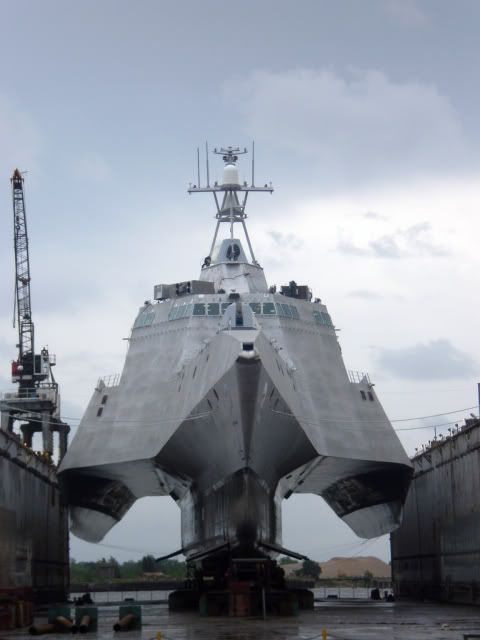Estás usando un navegador obsoleto. No se pueden mostrar estos u otros sitios web correctamente.
Se debe actualizar o usar un navegador alternativo.
Se debe actualizar o usar un navegador alternativo.
Noticias de la Marina de Israel
- Tema iniciado Guitro01
- Fecha de inicio
ES ESTE MISMO???
Lockheed Martin ha mostrado su diseño LCS-I, especialmente preparado para la Marina de Israel.
Los principales cambios son: sistema AEGIS Spy-1F, sistemas Raphael Typhoon, misiles Barak y Standard SM-2 ( lanzador de 16 celdas ).

TIRADOR SOLITARIO
Lockheed Martin ha mostrado su diseño LCS-I, especialmente preparado para la Marina de Israel.
Los principales cambios son: sistema AEGIS Spy-1F, sistemas Raphael Typhoon, misiles Barak y Standard SM-2 ( lanzador de 16 celdas ).

TIRADOR SOLITARIO
S
SnAkE_OnE
Perfectirijillo
Colaborador
acá algo qu encontré de esta joyita, pedazo de buque....
mirense este PDF
http://www.defenseindustrydaily.com/files/LCS_Lockheed_Israel_Variant_Brochure.pdf

Lockheed Martin continues its preliminary design work on a Littoral Combat Ship (LCS) proposed to the Israeli Navy's (known as LCS-I). The company was awarded further $2.3 million funding for nine-month combat system configuration phase, producing the technical specification and acquisition cost package for the LCS-I combat system for the US and Israel Navy. This phase will examine the LCS with two radar systems, the advanced radar under development by Elta Systems division of Israeli Aircraft Industries (IAI) and the SPY-1F developed by Lockheed Martin. (More...)
Both systems will be examined using the COMBATSS-21 combat management system integrated with the Israeli Navy Command and Control (IC2) system and various weapon systems such as MK 41 Vertical Launch System (VLS), Typhoon gun and Barak 8 missiles. Cost and high level integration requirements for multiple Israeli and U.S. sensor and weapon systems will also be examined.
Lockheed Martin received an initial contract from the Israeli Navy in February 2006 to perform a feasibility study for a multi-mission LCS variant. The study, successfully completed in April 2007, resulted in the Israeli Defense Forces' (IDF) decision to approve initial funding for two multi- mission ships currently based on an LCS-I design that would include anti-air, anti-submarine, anti-surface and anti-missile warfare missions, as well as special operations. Lockheed Martin is currently partnered with Rafael Armament Systems, Elbit Systems and Ness on LCS-I.
"The feasibility study successfully validated the capability of the Lockheed Martin LCS design to support the Israeli Navy's multi-mission requirements. LCS-I will provide the Israeli Defense Force a strategic asset, fully interoperable with the U.S. Navy, to support both asymmetric warfare and broader national security roles," said Joshua Shani, vice president of Lockheed Martin Israel Operations. "Lockheed Martin will continue to work closely with the Israeli Navy, the U.S. Navy and Israeli industry during the combat system configuration phase."
The Israeli LCS variant will be based on the Freedom class designed by Lockheed Martin for the US Navy. The ship uses a semi-planing steel monohull, which provides optimal maneuverability and seakeeping characteristics to support launch and recovery operations, mission execution and optimum crew comfort. Utilizing the flexible 'mission module' concept the LCS is designed as a versatile multi-mission platform. The vessel's propulsion system will be based on a combined diesel and gas turbine (CODAG) with steerable waterjets. The vessel's weapon systems could include the STANDARD Missile 2 or Barak 8 air defense missiles used for the primary defensive weapon, Boeing Harpoon II or IAI/Gabriel V used as the primary offensive weapons, and BAE Systems' MK 32 surface vessel torpedo tubes (SVTT) , to be used as a primary anti-submarine weapon, firing Mk 46 or Mk 50 torpedoes.
The first LCS built for the US Navy, LCS 1 Freedom is undergoing outfitting and testing at Marinette Marine Corp. in Marinette, WI. The vessel is scheduled for delivery in 2008 and will be stationed at the San Diego naval base. The US Navy cancelled further acquisition of both Freedom class LCS, as well as the competing Independence class, due to substantial cost overruns incurred in the cost plus based program. Israel and Saudi Arabia are two potential customers for the LCS design, while the US Navy expressed its commitment to pursue further LCS acquisitions, it remained illusive about the specific platform and contractual tools to be pursued. The Navy wanted to move the program from cost plus basis to fixed price, in an attempt to control the escalating costs, blamed partially in a new design oversight concept and frequently changing requirements made by the Navy, which necessitated major changes late in the development program.
mirense este PDF
http://www.defenseindustrydaily.com/files/LCS_Lockheed_Israel_Variant_Brochure.pdf
Perfectirijillo
Colaborador
debería ser la tuya Rojo, esa es de una LCS-I (Israel's Littoral Combat Ship Program)
Son ambos, y antes hubo un tercer diseño que finalmente se cancelo..
son interesantisimos, pero la verdad es que es la forma mas cara de la tierra de mover un C2, algunos SSM , SAM y una serie de pallets modulares de mision...en el papel se ven como la muerte en bote, con 45 nudos de velocidad de crucero y demases...pero cosas como el casco de aleacion ligera ( para permitir los 45 nudos..), y una enorme cantidad de sistemas experimentales me hace pensar que son un lujillo que solo se puede pagar si tienes subsidio con los Yankees...
No son buques para gente normal..
yo personalmente tengo un affaire de amor platonico por los APD y fragatas danesas nuevas..
ESO si me quita el sueño.
y cuestan hasta un poco menos, pese a que son doños buques de 6600 tons.
Saludos,
Sut
son interesantisimos, pero la verdad es que es la forma mas cara de la tierra de mover un C2, algunos SSM , SAM y una serie de pallets modulares de mision...en el papel se ven como la muerte en bote, con 45 nudos de velocidad de crucero y demases...pero cosas como el casco de aleacion ligera ( para permitir los 45 nudos..), y una enorme cantidad de sistemas experimentales me hace pensar que son un lujillo que solo se puede pagar si tienes subsidio con los Yankees...
No son buques para gente normal..
yo personalmente tengo un affaire de amor platonico por los APD y fragatas danesas nuevas..
ESO si me quita el sueño.
y cuestan hasta un poco menos, pese a que son doños buques de 6600 tons.
Saludos,
Sut
ni siquiera, fijate que ya USA los canselo y solo se construiran 2.. .ahora Israel quiza sea otro cantar.... les encantan los buques caros!!!!Son ambos, y antes hubo un tercer diseño que finalmente se cancelo..
son interesantisimos, pero la verdad es que es la forma mas cara de la tierra de mover un C2, algunos SSM , SAM y una serie de pallets modulares de mision...en el papel se ven como la muerte en bote, con 45 nudos de velocidad de crucero y demases...pero cosas como el casco de aleacion ligera ( para permitir los 45 nudos..), y una enorme cantidad de sistemas experimentales me hace pensar que son un lujillo que solo se puede pagar si tienes subsidio con los Yankees...
No son buques para gente normal..
yo personalmente tengo un affaire de amor platonico por los APD y fragatas danesas nuevas..
ESO si me quita el sueño.
y cuestan hasta un poco menos, pese a que son doños buques de 6600 tons.
Saludos,
Sut
-Estas unidades va ha venir a sustituir a las Fragatas Oliver H Perry


-Saludosss
estas unidades no sustituiran nada.. ya que se constriyeron solo esos 2 y se canselo el programa.. y las OHP se van a la baja sin sustitucion... lo unico que se seguira construyendo (y en cierta medida iran reemplazando a las OHP) seran los Burke.. que ya se estan planteando (en una version modernizada) como sustitutos del malogrado DDX.. que tampoco se construira...
no si son locos y gastan fortunas... pero no comen vidrio!!!
estos barcos serian el reemplazo ideal para los veijisimos patrulleros KIN/MURATURE?, si tienen misiles STANDARD darian buena cobertura a Buenos Aires.
tenes una idea de lo que valen????.. como reemplazo de patrulleros?? calcula que aca no se define la construccion de las POM/PAM que son cascos super simples sin casi armamentos ni sistemas ni anda.... y planteas un LCS como reeplazo??? :svengo: :svengo: :svengo: :svengo:
para darte una idea ... con uno solo de estos construis unos...... 10 POM maso...
Duwa
Master of the Universe.
No sabia que los habian cancelado. Cancelan los destructores y tambien estos... estan hasta las manos. No tenia idea que estos barcos furan tan caros. Pensaba que teniendo poco desplazamiento, armamento y sistemas bastantes basicos pense que eran una opción barata a la fragata. Me parece que dentro de poco van a tener que revivir el proyecto o sacar una linea de fragatas nueva porque se queda solo con unidades de superficie mayores, caras de mantener y para muchas funciones seran un "overkill". Una pena, me encantaba el trimaran.fijate que ya USA los canselo y solo se construiran 2
se cancelan pq justamente resultan "demasiado caros" para la funcion que van a cometer.... como dijo SUT "es la forma mas cara de la tierra de mover un C2, algunos SSM , SAM y una serie de pallets modulares de mision" cuando hay en el mercado diseños que hacen funciones similares por una fraccion de lo que valen estos...
en cuanto al DDX.. mas de lo mismo... salen casi tan caros cada uno como un SSN Virginia... y hoy esta claro que USA prefiere poner en grada mas SSN que algunos caros DDX... aclaro que yo haria exactamente lo mismo.
en cuanto al DDX.. mas de lo mismo... salen casi tan caros cada uno como un SSN Virginia... y hoy esta claro que USA prefiere poner en grada mas SSN que algunos caros DDX... aclaro que yo haria exactamente lo mismo.
Perfectirijillo
Colaborador
Alex, cuanto cuestan?...$ 250M... tengo la sensación que salen algo mas que eso
los costos iniciales de proyecto (año 2005) eran de 220M c/u para un total de 55 unidades...
lamentablemente, la crisis, el incremento de requerimientos y la dificultad de lograrlos hizo que los costos actuales tanto del LCS-1 como del 2 se dispararan al doble de esa cifra..
y para el FY2009 se esperaba que rondaran los 500M por unidad....
se entiende entonces el pq de la demora/cancelacion del programa no???
lamentablemente, la crisis, el incremento de requerimientos y la dificultad de lograrlos hizo que los costos actuales tanto del LCS-1 como del 2 se dispararan al doble de esa cifra..
y para el FY2009 se esperaba que rondaran los 500M por unidad....
se entiende entonces el pq de la demora/cancelacion del programa no???
Temas similares
- Respuestas
- 22
- Visitas
- 13K
- Respuestas
- 1
- Visitas
- 6K
- Respuestas
- 94
- Visitas
- 18K



